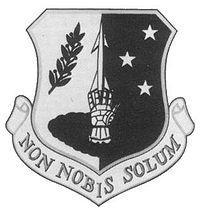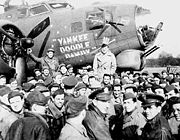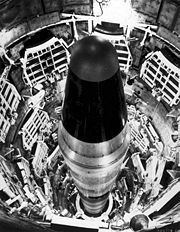390th Strategic Missile Wing
From Wikipedia, the free encyclopedia
| 390th Strategic Missile Wing | |
|---|---|
 390th Strategic Missile Wing Insignia |
|
| Active | 1943 - 1945 (USAAF) 1962 - 1984 (USAF) |
| Country | United States |
| Branch | United States Air Force |
| Role | Bombardment |
| Part of | Strategic Air Command |
The 390th Strategic Missile Wing was a United States Air Force Strategic Air Command organization. Its mission was to maintain and operationally control intercontinental ballistic missile's (ICBM). During World War II, the 390th Bombardment Group was a part of the United States Army Air Forces Eighth Air Force. It was deployed to England and performed strategic bombardment.
Contents[hide] |
[edit] History
[edit] Operational units
- 568th Bomb Squadron (BI) (1943-45)
- 569th Bomb Squadron (CC) (1943-45)
- 570th Bomb Squadron (DI) (1943-45)
- 570th Strategic Missile Squadron (1962-84)
- 571st Bomb Squadron (FC) (1943-45)
- 571st Strategic Missile Squadron (1962-84)
[edit] Aircraft flown
- Boeing B-17 Flying Fortress (World War II)
[edit] Stations assigned
- Geiger Field, Washington 26 Jan 1943 - 5 Jun 1943
- Great Falls AAB/Gore Field, Montana 6 Jun - 4 Jul 1943
- RAF Framlingham, England Jul 1943 - 4 Aug 1945
- Sioux Falls AAFld, South Dakota 12 - 28 Aug 1945
- Davis-Monthan AFB, Arizona 1 Jan 1962 - 30 Jun 1984
[edit] Operational history
[edit] World War II

Constituted as 390th Bombardment Group (Heavy) on 15 Jan 1943 and activated on 26 Jan. Prepared for combat with B-17s. Moved to England in Jul 1943 and assigned to Eighth Air Force. The 390th was assigned to the 13th Combat Bombardment Wing, and the group tail code was a "Square-J".
The group operated as part of the Eighth Air Force's strategic bombing campaign and operated chiefly against strategic objectives, flying many missions with the aid of pathfinders. The 390th began combat on 12 August 1943. Five days later, the group attacked the Messerschmitt aircraft complex at Regensburg and received a Distinguished Unit Citation for the mission.
The 390th received a 2d DUC for a mission on 14 October 1943 when the group braved unrelenting assaults by enemy fighters to bomb the antifriction-bearing plants at Schweinfurt. Participating in the intensive Allied assault on the German aircraft industry during Big Week, 20-25 February 1944, the organization bombed aircraft factories, instrument plants and air parks. Other strategic missions included attacks on marshalling yards at Frankfurt, bridges at Cologne, oil facilities at Zeitz, factories at Mannheim, naval installations at Bremen and synthetic oil refineries at Merseburg.
The group sometimes flew interdictory and support missions. Bombing the coast near Caen fifteen minutes before the landings in Normandy on 6 June 1944. Attacked enemy artillery in support of ground forces during the breakthrough at St Lo in July. Cut German supply lines during the Battle of the Bulge, December 1944-January 1945. Hit airfields in support of the airborne assault across the Rhine in March 1945.
The 390th Bomb Group flew its last combat mission on 20 April 1945. In over 300 missions, they dropped 19,000 tons of bombs. They lost 181 aircraft and seven hundred and fourteen airmen were killed. The group dropped food supplies to the Dutch during the week prior to V-E Day.
The unit returned to Sioux Falls AAF South Dakota during August and was inactivated on 28 August 1945.
[edit] DFC Recipients from 390th BG
| Herbert H. Alexander | Kenneth Allebach | John H. Alvey | Andrew Anzanos |
| Andrew J. Archipole | Ray Armstrong | Darwin E. Arnold | Walter A. Backman |
| Charles R. Bennett | James S. Bennett | Richard C. Berryman | Robert J. Billington |
| Wade Birmingham | Vincent J. Black | Lester E. Boettcher | William H. Bowman |
| William H. Breeze | Max Brier | Jack T. Bright | Robert N. Brown |
| Robert H. Buhrmaster | Bernard M. Campbell | William A. Catto | William R. Centerwall |
| Orman M. Coffin | Fletcher F. Conn | Harold M. Cummings | Robert L. Datz |
| Samuel O. Davis | Louis W. Dolan | Kenneth E. Dougherty | Henry C. Douglas, Jr. |
| George W. Durkee | John A. Embry | Edgar C. Engelbrecht | Delmer D. Everly |
| James P. Fitzsimmons | Richard A. Foster | Scott P. Gerhart | Jack M. Giles |
| Robert O. Good | William K. Gower | Chester P. Gunn | Robert N. Hale |
| Ray R. Hall | Elmer C. Hanselman | High H. Hardwicke Jr. | Crockett L. Harmon |
| Warren L. Hasse | Warren H. Hawes | Maurice M. Heaton Jr. | Edgar C. Heeseler |
| Robert A. Heiser | Robert M. Henry | John J. Hickey | Patrick H. Hodgkin |
| Philip D. Holman | Elbert R. Hoover | Milton S. Houser | Robert S. Jacobs |
| Charles S. Jager | Thomas S. Jeffrey | Ora L. Jenkins | Clifford H. Jernigan |
| Marvin C. Johns | Stanley A. Johnson | George F. McInerney | Edwin McMichael |
| Howard F. Menadier | Jack Miller | Joseph A. Moller | Edgar W. Moody |
| Frederick W. Ott | Robert H. Padbury | David P. Parry | William F. Pennebaker |
| Robert F. Redlinger | Robert W. Sabel | Edmund D. Shaw | Marshall B. Shore |
| Berton S. Spring | Clarence A. Strawn | Robert G. Stutzman | Robert M. Tuttle |
| George W. Von Arb | Robert W. Waltz | Robert W. Watts | Gene O. Williams |
| Edgar M. Wittan | |||
[edit] Cold War
On April 20, 1960, the Fifteenth Air Force announced selection of the base to support a Titan II missile wing. The January 1, 1962, activation of the 390th Strategic Missile Wing (SMW) marked the first standing up of a Titan II missile wing.
Its two component squadrons were the Arizona Sites 570th and the 571st Strategic Missile Squadrons.
Launcher locations for the 570th SMS were at Oracle, Three Points, Rillito (4 silos), and Oracle Junction (3 silos). The 571st SMS silos were located at Benson (2 silos), Mescal, Pantano, Continental (2 silos), Palo Alto, and Three Points. On March 31, 1963, site 570-2 (Three Points) was turned over to SAC for operational use. Additional silos joined the SAC inventory until November 30, when the 18th and final Titan II went on alert.
The 390th SMW became the first operational Titan II missile wing in the Air Force.
With a requirement to keep all 18 missiles on alert status around the clock, maintenance personnel often put in 80- to go-hour work weeks. Eventually, response times to act on maintenance problems were loosened to allow crews to react during normal working hours. Maintenance did ease at the end of 1964, as the Davis-Monthan silos became the first to receive "Project Green Jug" treatment entailing the installation of dehumidifier equipment that eased corrosion problems within the silos. Additional modifications would be made to increase missile reliability, survivability, and reaction time. Also toward the end of 1964, the 390th SMW underwent the first operational readiness inspection for a Titan II unit.
On January 25, 1965, Vice President Hubert H. Humphrey toured complex 571-7. One month later, the 390th SMW performed the first operational launch test of one of its Titan 11s at Vandenberg AFB, California. Many more successful tests followed.
Competing in SAC's first ever missile competition called "Project Curtain Raiser" in 1967, the 390th SMW garnered the first "best crew" trophy. Since 1967, the Wing earned many additional accolades at these competitions which became known as "Olympic Arena."
In October 1981, President Ronald Reagan announced that as part of the strategic modernization program, Titan II systems were to be retired by October 1, 1987. Deactivation began at Davis-Monthan on October 1, 1982. During the operation, titled "Rivet Cap," the missiles were removed and shipped to Norton AFB, California for refurbishment and storage. Explosive demolition began at the headworks of missile complex 570-7 on November 30, 1983. During the following May, the last Titan II at Davis-Monthan came off alert status.
Two months later, SAC deactivated the 390th Strategic Missile Wing.
[edit] See also
[edit] References
![]() This article incorporates public domain material from websites or documents of the Air Force Historical Research Agency.
This article incorporates public domain material from websites or documents of the Air Force Historical Research Agency.
[edit] Notes
[edit] Bibliography
- Anzanos, Andy. My Combat Diary With Eighth Air Force B-17s 390th Bomb Group. Lulu.com, 2006. ISBN 1-41169-830-4.
- Drain, Richard E. 390th Bomb Group: History of the Aircraft Assigned. Selfpublised manuscript, 1993.
- Maurer, Maurer. Air Force Combat Units Of World War II. Maxwell Air Force Base, Alabama: Office of Air Force History, 1983. ISBN 0-89201-092-4.
- Milliken, Albert E. (ed.) The Story of the 390th Bombardment Group (H): The Unit History of the Square J Group of the Eighth Air Force, European Theater of Operations, 1943-1945. New York: Eilert printing Company, 1947.
- Perry, Richard H. (ed.) The 390th Bomb Group Anthology, Volume II. Tucson, Arizona: 390th Memorial Museum Foundation, 1985.
- Ravenstein, Charles A. Air Force Combat Wings Lineage and Honors Histories, 1947-1977. Maxwell Air Force Base, Alabama: Office of Air Force History, 1984. ISBN 0-91279-912-9.
- Richarz, Wilbert H. with Richard H. Perry and William J. Robinson. The 390th Bomb Group Anthology. Tucson, Arizona: 390th Memorial Museum Foundation, 1983.
- Richarz, Wilbert H. with Richard H. Perry and William J. Robinson. The 390th Bomb Group Anthology, Volume II. Tucson, Arizona: 390th Memorial Museum Foundation, 1985.
- 390th Bombardment Group: 50th Anniversary Commemorative History. Paducah, Kentucky: Turner Publishing Company, 1994. Republished 1997.
[edit] External links
|
|||
|
|||





